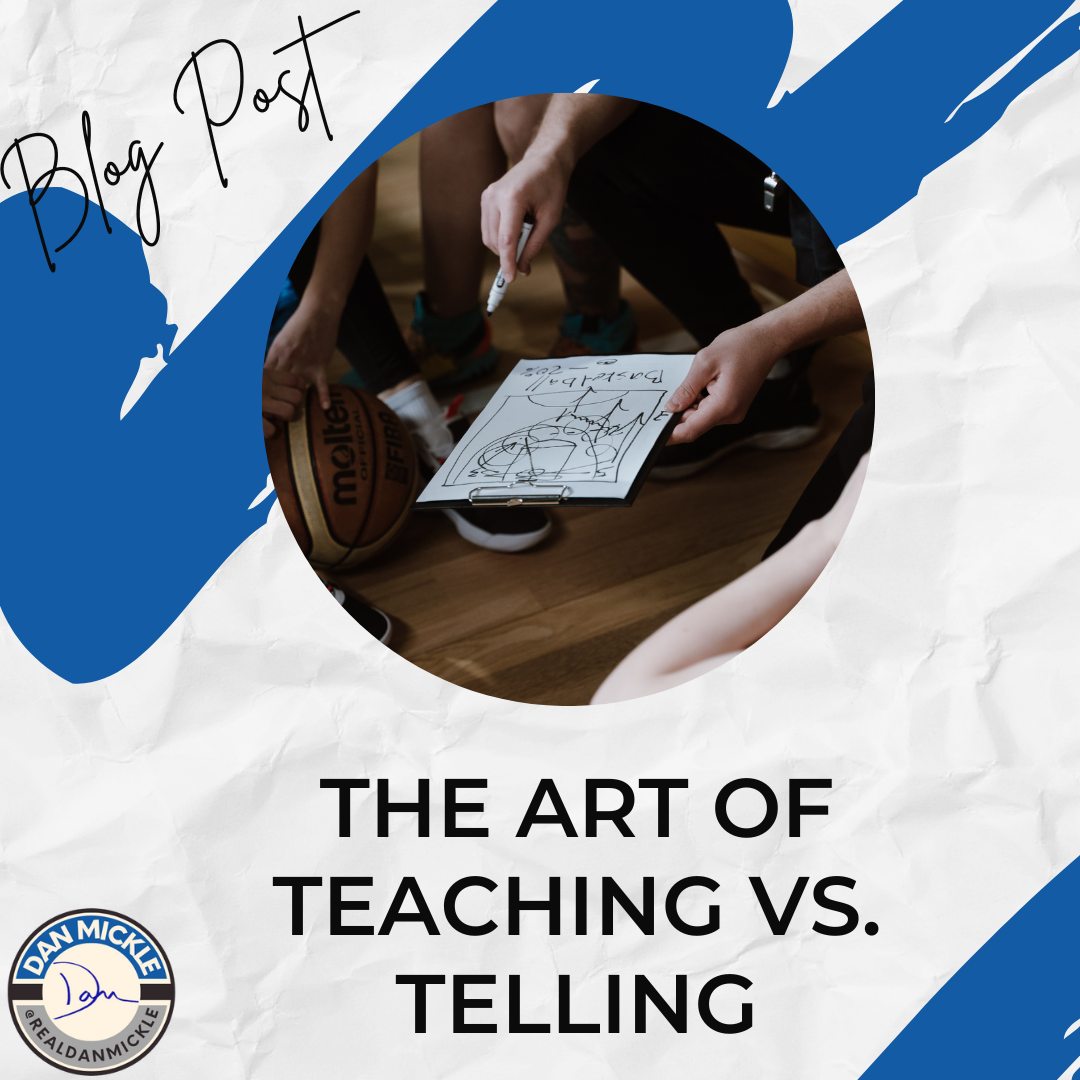The Art of Teaching vs. Telling: Why Youth Coaches Must Be Educators
As a mental performance coach and member of a national coaching education cadre, I’ve witnessed a curious phenomenon: coaches who think they’re teaching when they’re really just telling. It’s like watching someone yell at their dog, expecting it to understand calculus. (Spoiler alert: It doesn’t.) The art of coaching goes far beyond issuing commands or doling out advice. It’s about teaching—really teaching—in a way that inspires learning, growth, and understanding in young athletes.
If you’re a youth coach, you’re not just teaching kids how to dribble a soccer ball, hit a volleyball, or perfect their backstroke. You’re shaping their minds, building their character, and laying the groundwork for how they approach challenges in life. It’s a huge responsibility—and one that demands you become an educator, not just a teller. Let’s dive into what that really means.
Telling vs. Teaching: What’s the Difference?
Imagine this scenario: It’s halftime during a youth basketball game. The team is down by 10 points, and the coach says, “You guys need to play better defense and stop turning the ball over!” Technically, that’s advice. But it’s not teaching.
Now, imagine the same coach says: “We’re going to tighten up our defense by staying between our player and the basket. Let’s focus on short, controlled passes to reduce turnovers. Watch this—here’s how you pivot to avoid a steal.” See the difference? One approach simply tells the athletes what to do, while the other teaches them how to do it.
Teaching involves breaking concepts down, using relatable examples, and ensuring your athletes understand the “why” behind the “what.” Telling, on the other hand, is like throwing spaghetti at a wall and hoping it sticks.
Why Coaches Default to Telling
Coaching youth athletes is no small feat. You’re juggling drills, game plans, emotional outbursts (both yours and theirs), and often a gaggle of parents who think their 10-year-old is the next LeBron James. In the chaos, it’s easy to fall into the trap of telling because it’s quick and feels efficient. But here’s the kicker: telling isn’t teaching, and it rarely leads to lasting improvement.
Here are three common reasons coaches default to telling:
- Time Pressure: You’ve got a limited practice window and a long list of things to cover.
- Frustration: When athletes don’t “get it,” the temptation to bark orders can be overwhelming.
- Lack of Awareness: Many coaches don’t realize they’re telling instead of teaching. They’re repeating the patterns they experienced as athletes.
The Case for Teaching
Teaching is about creating understanding, and understanding leads to better execution. When athletes understand why they’re doing something, they’re more likely to buy into it, repeat it, and improve over time. Teaching also:
- Builds Confidence: When athletes know how to execute a skill, they feel capable.
- Fosters Independence: Teaching equips athletes to problem-solve on their own.
- Creates Better People: The lessons you teach on the field or court often translate into life skills—teamwork, resilience, and critical thinking.
How to Shift from Telling to Teaching
So, how do you make the shift? Here are actionable tips to transform your coaching style and embrace the art of teaching.
1. Ask, Don’t Tell
Instead of telling your athletes what they did wrong, ask them what they noticed. For example:
- Telling: “You missed that because you were off balance.”
- Teaching: “Why do you think that shot didn’t go in?”
This approach encourages athletes to reflect and self-correct, which deepens their learning.
2. Model the Behavior
Show, don’t just tell. Demonstrate the skill or tactic you want to teach. Better yet, break it down into steps and explain what you’re doing as you go. Bonus points if you let your athletes critique your form—they love that.
3. Use Analogies
Kids respond well to relatable comparisons. Want to teach proper sprint form? Tell them to imagine they’re running like a cheetah. Trying to explain how to stay light on their feet? Compare it to dancing on hot coals. Humor and creativity go a long way.
4. Focus on One Thing at a Time
Don’t overload your athletes with information. Pick one specific skill or concept to work on, and stay consistent. If you’re working on passing in soccer, don’t also try to fix their shooting technique in the same session. Think of it like teaching someone to juggle—start with one ball, then add more.
5. Celebrate the Process, Not Just the Outcome
Encourage effort and improvement, even when the results aren’t perfect. If a player tries a new technique and it doesn’t work, praise their willingness to attempt it. This builds a growth mindset and keeps the learning process enjoyable.
6. Adapt to Learning Styles
Not every athlete learns the same way. Some need to see it (visual learners), others need to hear it (auditory learners), and some need to physically do it (kinesthetic learners). Mix up your teaching methods to reach everyone.
A Personal Anecdote: My Own “Aha” Moment
I’ll never forget a youth soccer game where I saw a coach tell his players to “pressure the ball!” over and over, growing increasingly agitated as they failed to execute. Afterward, I asked one of the kids what “pressure the ball” meant. He shrugged and said, “I think it means run at the guy with the ball, but I’m not sure.”
That moment stuck with me. The coach was frustrated because his players weren’t doing what he wanted, but the real problem was that they didn’t understand what he meant. It wasn’t their fault—it was his failure to teach.
How Teaching Impacts Athletes Long-Term
When you take the time to teach, you’re not just building better athletes—you’re building better humans. Athletes who are taught, not told, develop:
- Critical Thinking Skills: They learn to assess situations and make decisions.
- Resilience: They understand that improvement comes through effort and learning from mistakes.
- Leadership Qualities: Athletes who grasp concepts deeply can mentor their teammates.
Perhaps most importantly, athletes who are taught feel valued. They know their coach cares enough to invest time in their growth, and that can make all the difference in their athletic and personal journeys.
Let’s Be Honest: It’s Not Always Easy
Teaching takes patience—a lot of it. There will be moments when you want to revert to telling because it’s quicker, easier, and less emotionally taxing. But remember, the best coaches aren’t the ones who simply demand results; they’re the ones who guide their athletes to achieve those results themselves.
A Quick Summary for Your Coaching Toolbox
- Ask questions to promote reflection and understanding.
- Demonstrate skills to give athletes a clear visual.
- Simplify and focus on one thing at a time.
- Adapt to individual learning styles within your team.
- Celebrate effort as much as achievement.
- Use analogies and humor to make concepts stick.
Closing Thoughts
As youth coaches, we have an extraordinary opportunity to shape the future—not just the future of sports, but the future of the individuals we coach. When we embrace the art of teaching instead of defaulting to telling, we elevate our role from coach to educator. We become mentors, guides, and champions of growth.
So, the next time you feel tempted to bark orders or issue commands, take a breath and ask yourself: “Am I teaching, or am I just telling?” Because the difference isn’t just semantic—it’s transformative.
Now, go forth and teach like a Jedi Master. (But maybe leave the lightsaber at home.)


